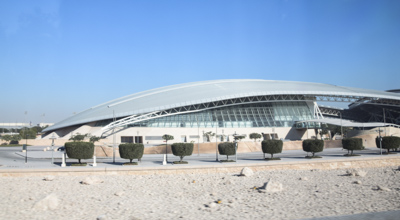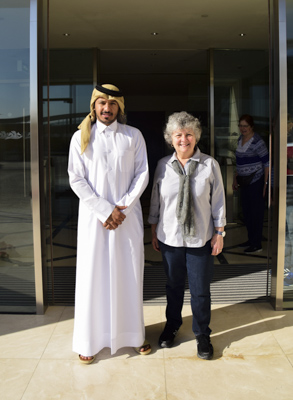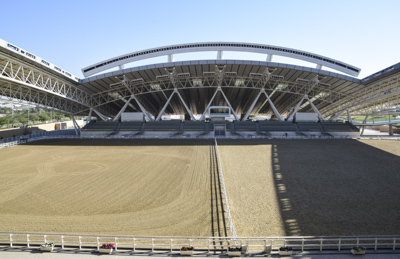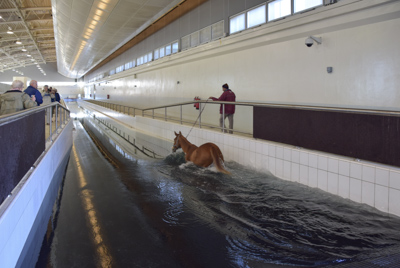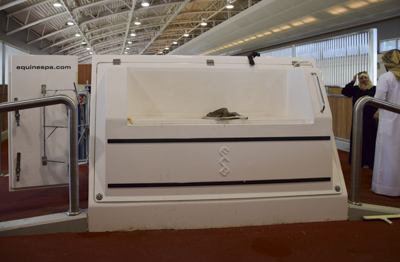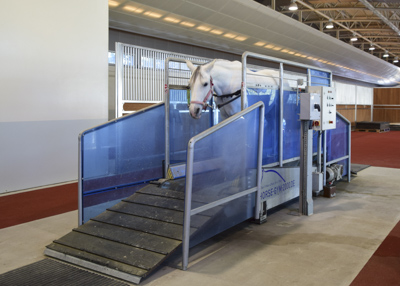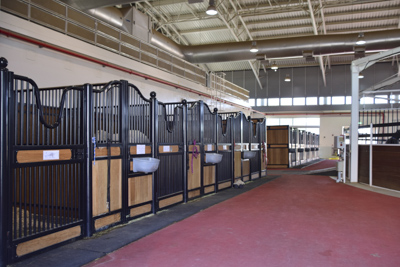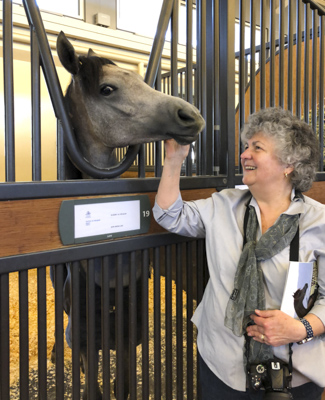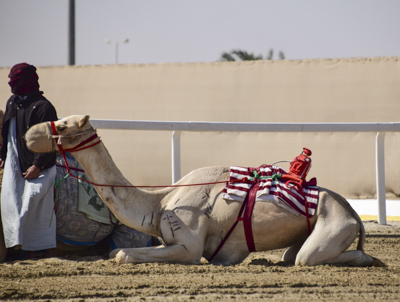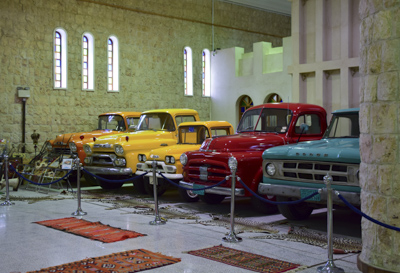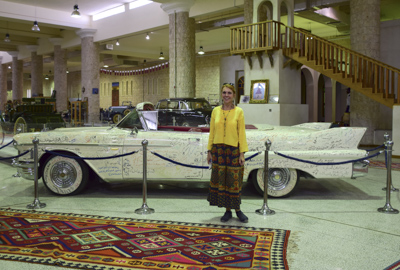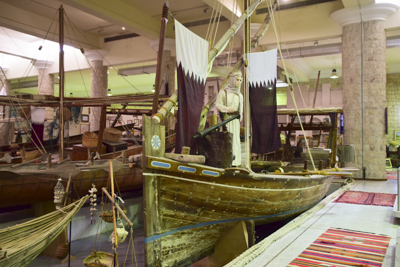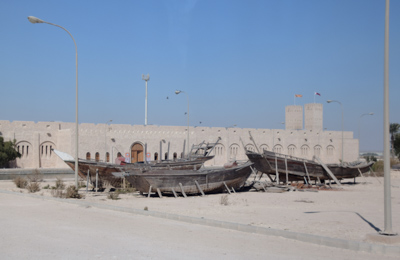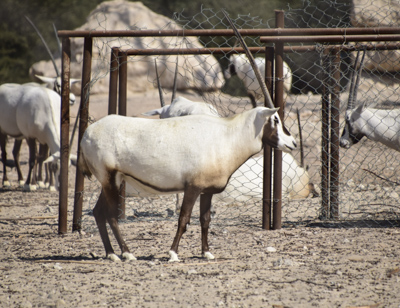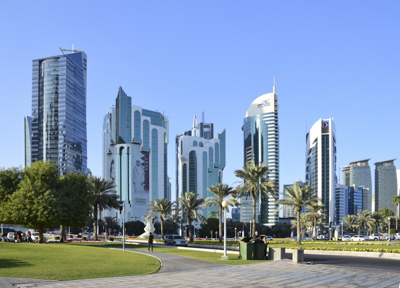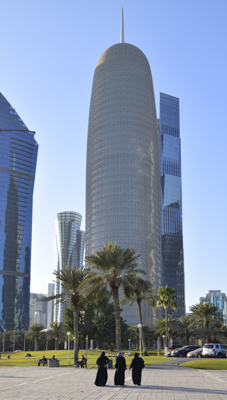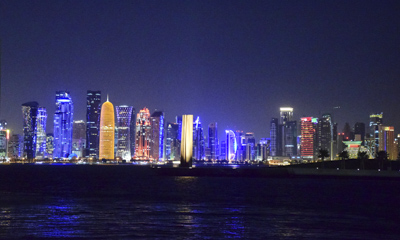Thursday – February 1, 2018
Today was our day to drive out of the capital city of Doha and go into the desert to experience some hobbies of the wealthy Qataris. We passed communities of large houses along the highway. Every citizen of Qatar receives a generous monthly salary, housing and utilities, as well as free education through college, and free health care.
After a 40 minute drive through the white-sand desert of Qatar, we arrived at Al Shaqab. This is the Qatar Foundation’s equestrian center where Arabian horses are bred, trained, boarded, and compete against each other. Our bus driver parked near the main building which looks like a silver space ship.
We were greeted by one of the managers of the equestrian center who described the huge facility with the aid of a diorama.
Al Shaqab was founded in 1992 and created in the shape of a horseshoe. The indoor arena is fully air-conditioned with a retractable roof and a seating capacity for 6,000 people. The stables are also air conditioned and have accommodations for more than 400 horses. There is also housing for handlers, competitors, grooms, and staff.
A full service riding academy is on the grounds. There are also endurance facilities, an equestrian club, exercise center for the horses, and a complete veterinary center. We watched attendants exercise several horses in a pool and on a horse treadmill. We also saw the large equine jacuzzi.
The stables were incredibly clean and had no animal smell. Hay is flown in daily from the American state of Kentucky as part of the Arabian horses’ special diets.
During our tour, we followed the guide outside to watch a training session. All the horses were beautiful and very friendly and responsive to people. Their coats were clean and soft and silky. Each horse had its own handler and a team of caretakers. Unbelievable! Today, Qatar is famous for its prized multi-million dollar Arabian horses.
After our tour of Al Shaqab equestrian center, we drove a short distance to see another Arabian sport: camel racing.
The racing camels were sleek and skinnier than the handler’s camels. We learned that originally young boys were the jockeys in races, but today small “robots” are used. In the photo below, the robot is the small red attachment on the camel’s back.
Our tour bus drove along the race track as two camels practiced a run. The arm of the robot sets the pace for the camel during a race.
Our next stop was the Sheikh Faisal bin Qassim Al Thani Museum which was housed in an air conditioned building which looked like an old fort. Sheikh Faisal, a cousin of the ruling family, collected all the 15,000 artifacts over a span of 50 years.
Sheikh Faisal opened the museum to the public in 1998 “to preserve and promote the cultural heritage of Qatar by displaying traditional artifacts and artworks.” The objects were grouped into four main categories: Islamic Art, Vehicles, Coins & Currency, and Qatari Heritage.
Among the cars, there were also bicycles and motor bikes. One of the motorcycles in the collection belonged to T.E. Lawrence, the British military officer during WWI known as ‘Lawrence of Arabia’.
My friend Linda, posed in front of the Sheikh’s autographed white Cadillac. The collection included furniture, household items, costumes, life-sized and model boats, fossils, sea shells, carpets, Islamic artifacts, etc., etc., etc. It was amazing!
Before we returned to Doha, we stopped at a preserve to see the national animal of Qatar, the Arabian Oryx. In the early 1970s, they were declared extinct in the wild. Through international efforts and special care, the Arabian Oryx is being saved from extinction. Its population today is estimated to be more than 1,000 Oryxes in the wild and about 7,000 in captivity worldwide.
It is believed that the Arabian Oryx was the historical basis for the mythical unicorn because the Oryx’s long horns sometimes appear to be a single horn. Today, the Oryx is the national animal of Jordan, Oman, the United Arab Emirates, Bahrain, and Qatar. As their national mascot, Oryx images can be found all over Doha and on Qatar Airways’ planes.
On our way back to our hotel, the bus stopped near the famous Doha Corniche: the seven kilometer waterfront promenade along the bay. Many of Doha’s landmarks are found along the walkway which begins near the Museum of Islamic Art and ends at the Sheraton Park Hotel.
Many traditional wooden boats called dhows were tied along the Corniche waiting for tourists go aboard and sail in Doha harbor.
We returned to the Grand Hyatt Hotel to rest before we had dinner at the Thai restaurant in the hotel called Issan. Afterwards, Celia, Dave, and I took a taxi to the center of Doha to photograph the city lights at night. Doha was ablaze with multi-colored lights illuminating the ‘skyscrapers.’ We had a great time! What a day!!!

